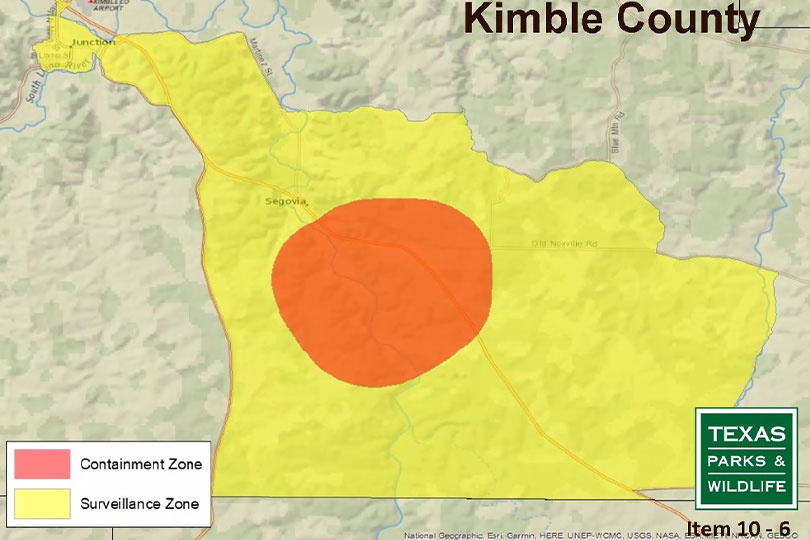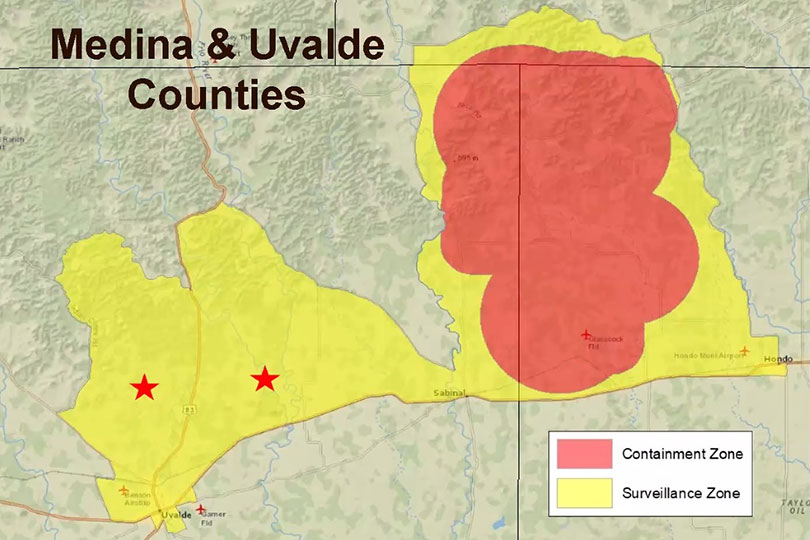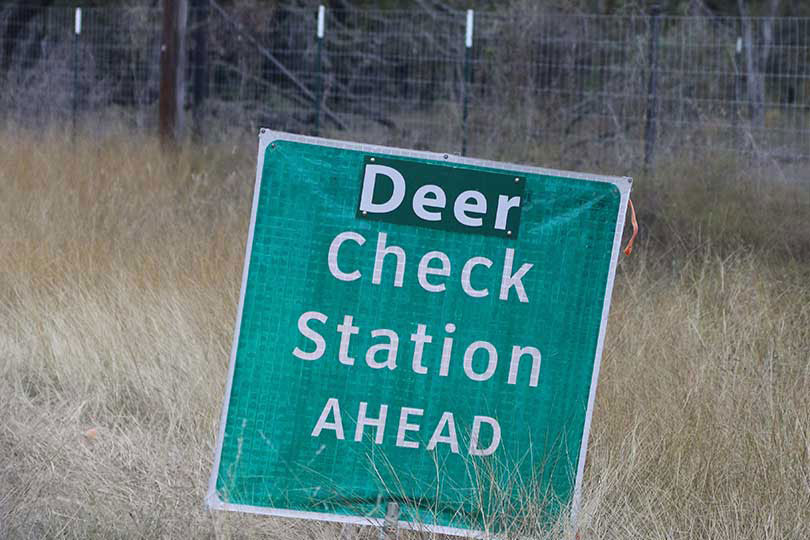By Jessica Domel
Multimedia Reporter
After hours of public comment and deliberation, the Texas Parks and Wildlife Commission last week approved a proposal creating two new Chronic Wasting Disease (CWD) zones and expanding two others.
The move impacts deer hunters and landowners in portions of eight counties: Bandera, Duval, Jim Wells, Kimble, Live Oak, McMullen, Medina and Uvalde.
“The requirements imposed on hunters are the same for both zones (containment and surveillance),” Mitch Lockwood, big game program director for the Texas Parks and Wildlife Department (TPWD), told the commission. “There’s mandatory sampling of hunter-harvested deer and carcass movement restrictions, which basically means that a carcass must be quartered before returning home from the deer lease and leaving those more risky carcass parts behind.”
Those who hunt in a CWD zone must take any cervid—including white-tailed deer, mule deer, red deer and elk—that was bagged in the zone to a TPWD check station within 48 hours of harvest.
CWD zones also come with live deer movement restrictions.
The commission’s approval creates a new containment zone and expansion of the surveillance zone in Kimble County in response to the detection of CWD in a deer breeding facility and adjacent release site.
“CWD was detected in a permitted deer breeding facility in Kimble County back in February of 2020, and the surveillance zone was established in response to that detection,” Lockwood said. “After two years of mandatory testing requirements, and at the request of constituents out there, staff have proposed a slight expansion to this surveillance zone to incorporate the city of Junction. This would allow hunters to legally transport whole carcasses to deer processing facilities there rather than have to quarter those carcasses first.”
After CWD was detected in the release site earlier this year, TPWD proposed the containment zone that would include all properties within two miles of the property where CWD has been detected.

The commission’s approval extends the current containment zone in Medina County to include parts of Bandera and Uvalde County.
“In the Medina County area, where we have been battling this disease since 2015, we’ve had a containment and surveillance zone established there during those years. The surveillance zone was expanded to the west last year in response to the detection of CWD in two additional deer breeding facilities,” Lockwood said. “Unfortunately, CWD was detected in new locations in the northern and southern end of the existing containment zone, necessitating another expansion of this zone.”
The expansion encompasses all land within five miles of the CWD positive cases in an area between Hondo and Uvalde.
The part of TPWD’s proposal that drew the most criticism from the public was the creation of a CWD surveillance zone in Duval County that would also impact hunters in Jim Wells, Live Oak and McMullen Counties.
The initial proposal would have included all land between Highway 44 to the south, Highway 59 to the west, FM 624 to the north and Highway 281 to the East. It would have included the cities of Alice in the southeast corner and Freer in the southwest corner.
TPWD received 566 comments on the proposal prior to the meeting on Aug. 25. Seventeen percent were in agreement with it. The rest opposed it.
With voluntary commitments from landowners to submit deer for CWD testing in the area, tests from properties in the Managed Lands Deer Program and others, Lockwood offered an additional proposal that would reduce the size of the zone by about 100,000 acres.

Freer and Alice are still included in the approved surveillance zone, to allow hunters to transport whole carcasses to processors, but large chunks of land between Freer and San Diego and San Diego and Alice are no longer included in the zone.
Although the hunter requirements for surveillance and containment zones are the same, the zones themselves are not.
Containment zones are used in areas where CWD is known to exist.
Surveillance zones cover areas that are at high-risk for CWD.
The purpose of creating these zones is to enhance efforts to monitor and contain CWD.
CWD is a fatal, neurological disease that affects cervids, including white-tailed deer, mule deer, elk and moose.
It is highly-contagious and can be spread by prions that may live in the environment, remaining infectious, for years.
According to TPWD, if left unmanaged, CWD can have catastrophic, long-term impacts on the native deer heard and local economies.
CWD symptoms, which may not be outwardly evident for years after infection, include: progressive weight loss, stumbling or tremors, lack of coordination, excessive thirst, salivation or urination, loss of appetite, teeth grinding, abnormal head posture and/or drooping ears.
To date, TPWD reports there is no evidence that CWD poses a risk to humans or non-cervids. However, as a precaution, the Centers for Disease Control and Prevention and the World Health Organization recommend against consuming meat from infected animals.
The new zones will be in place for the upcoming white-tailed deer and mule deer hunting seasons.
Before the season starts, hunters will be able to view all CWD zones in the state on the TPWD website. The site also includes the locations of CWD check stations and precautions hunters should take.
The information will also be available in the Outdoor Annual app and on OutdoorAnnual.com.

